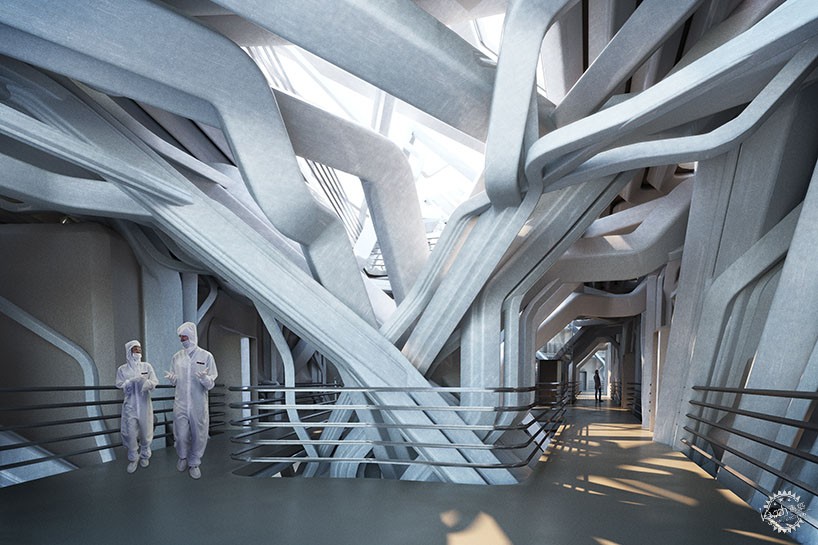
Solid studio suggests NANONANO Science Center as a sculptural network
由专筑网Yumi,严越编译
跨界的Solid工作室提出NANONANO科学中心的方案,他们牢记住两个全球性的研究话题。首先用适应性解决研究设备的“缺失”。其次,将公共服务和支座系统结合在一起。建筑师一直对灵活这一概念很感兴趣。即便这个领域被认为是一种静态的艺术,许多人都尝试让建筑包含这一变化的特性。
Interdisciplinary Solid Studio has developed the NANONANO science center proposal with two global research topics in mind. First, taking adaptability as a solution to the ‘extinction’ of research facilities. Second, merging utility services and bearing systems into one unit. The idea of flexibility in architecture has long intrigued designers. Even though the field is considered a static art, many attempts have been made to endow it with changeable features.
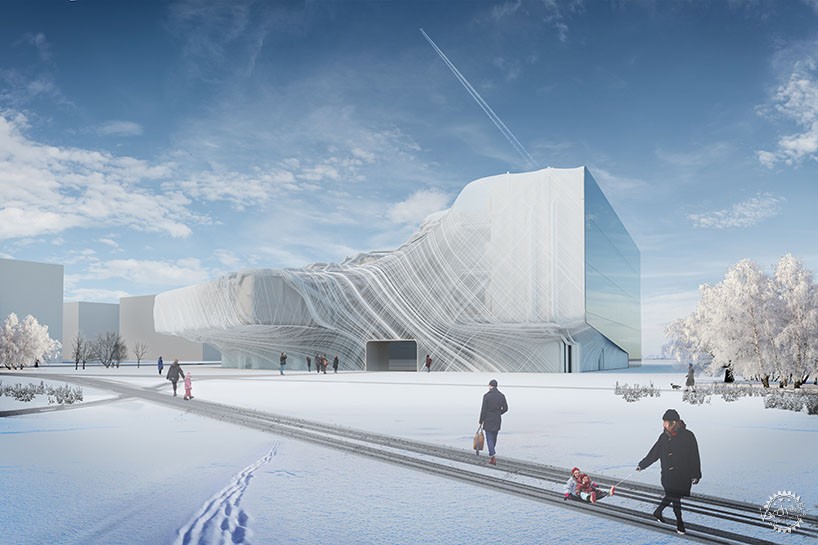
在俄罗斯斯科尔科沃的科学中心/Science center in Skolkovo, Russia
Solid对第一个话题的阐述是设想科学中心拥有变化的研究和服务设备。但是为什么要包含这种技术呢?在过去的几十年中,科学技术发展显著。在八十年代建造的综合体已无法应对现在的境况,比如新的和更好的机器所需的部分空间,或者某些建筑材料造成的灰尘积聚。正如团队所说,建筑本质上的稳态跟不上动态发展的脚步。然而,应对这些变化的答案无法在短时间产生;根据设计师的说法,为了更好的“维护”建筑,最佳的更新频率是10-15年。
Elaborating on the first topic, Solid Studio envisions the scientific centre with changeable research and service equipment.But why include this quality in a contemporary facility? For the last decades, the scientific agenda and requirements have evolved significantly. The complexes built in the eighties often couldn’t respond to unstable conditions, like the need of a section space for new and more powerful machines or the accumulation of dust due to certain building materials. As the team puts it, the ‘steady-state essence of architecture cannot keep up with the dynamics of progress’. However, this response to changing factors does not happen instantly; according to the designers, the optimal update rate is 10-15 years for a better architectural ‘preservation’.
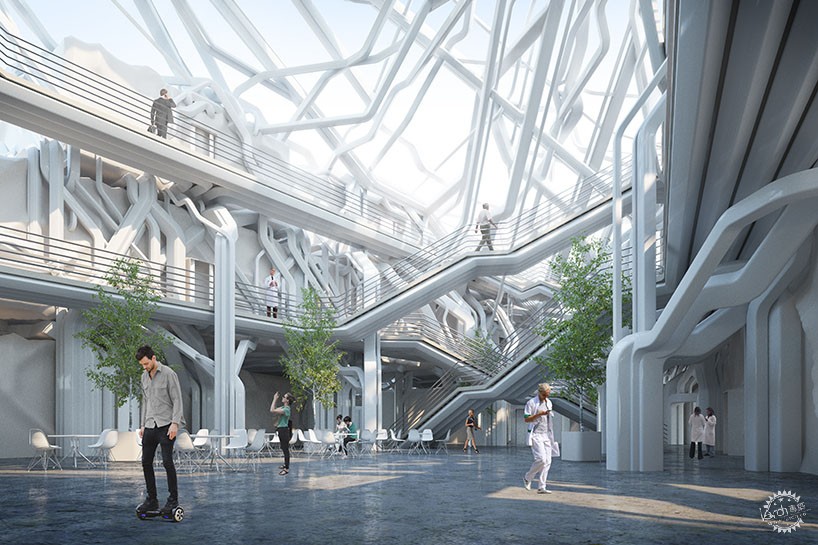
主要中庭的结构支撑系统/Main atrium with structural supply systems
在纳米科学领域,难题往往在于实验室和洁净室的空间规划。一般来说,两者的要求可以分成四组:精确控制湿度和温度、噪音和振动缓冲、空气净化、电磁和无线电波的阻隔。因此,当设计这些空间时,建筑师需要把额外的精力放在实验室和洁净室的分区上,以尽量减少相互之间的影响。
For the field of Nano science, complications often include the organization of laboratories and clean rooms. Conditionally, the requirements for both can be split into four groups: precise control of humidity and temperature, noise and vibration buffer, air purification, insulation against electromagnetic and radio waves. Therefore, when designing the space, architects need to pay extra attention to the location of labs and clean rooms to minimize mutual influence.
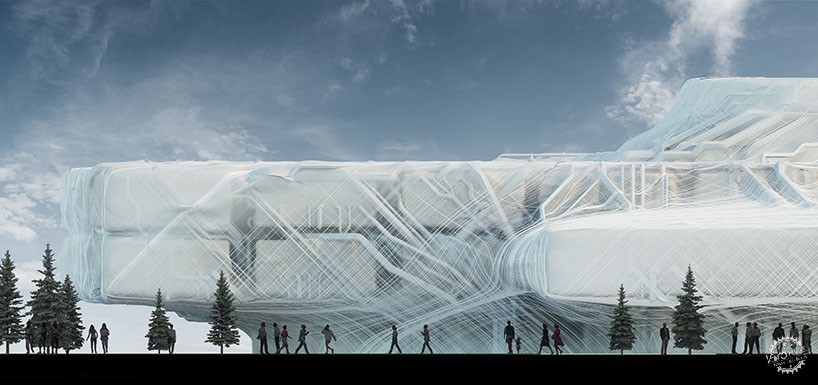
收缩塑料薄膜包裹的外表皮/Shrink-wrapped façade skin
由于实验室要保留专门的技术人员,该工作室把注意力放在这些房间之间的空间上,以及功能体块、公共空间、流线和适应性。每个实验室都有独立的隔离箱体,以便在不影响周围体块的情况下就能更换。像餐厅、厨房和办公室这样的辅助用房也被设计成独立的个体,分散在支撑结构和公用空间的间隙中。为保护内部的微气候,整个建筑被外壳包裹起来。据技术人员说,如果每十年需要升级一次建筑,圆柱形比方体的空间更具关联性、舒适性,并且更符合人体工程学。每次替换更新后,体块要重新包裹覆盖起来,所以外表皮也成为演变的主体。
Since laboratories are reserved for specialized technicians, the studio focuses on the space between such rooms, the functional volumes, public spaces, circulation and adaptability. Each lab has an independent isolation box that can be replaced without affecting others. Auxiliary facilities such as the canteen, kitchen, and offices are also set as individual hubs scattered throughout — where gaps serve as bearing and utility structures. Then, the entire program is wrapped by a shell to preserve the micro-climate within. According to technicians, if the building needs upgrading every decade, cylindrical labs are more relevant, comfortable and ergonomic than boxed spaces. After being replaced, the entire module is covered again with a protective shell. Hence, with this cycle, the exterior skin also becomes an evolutionary body.
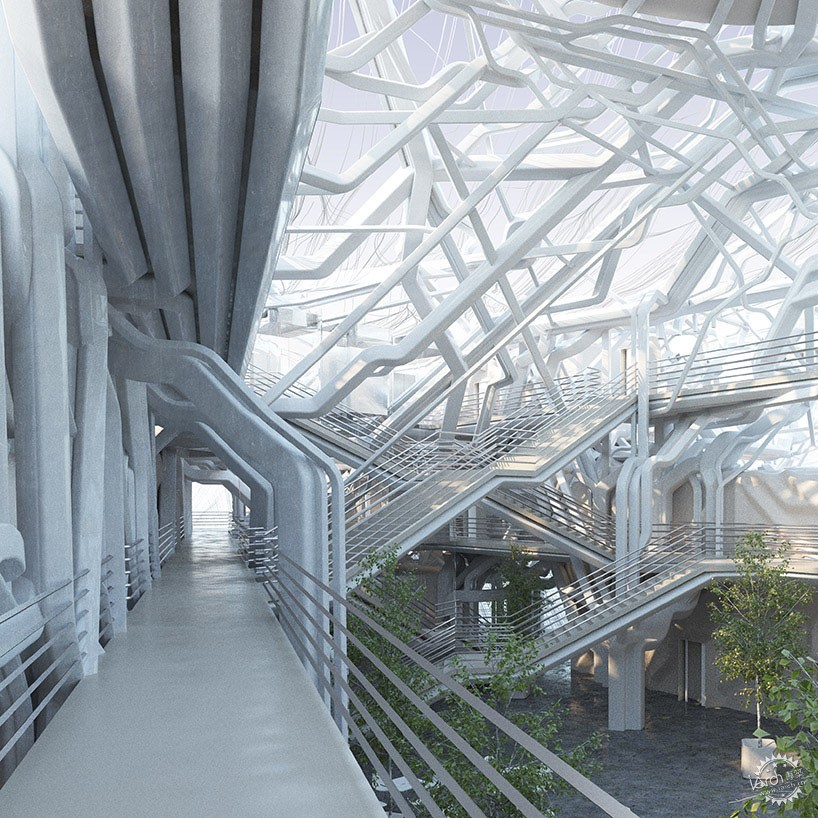
设想的科学中心内部/Interior of the proposed science center
工作室开始着手项目的第二个主题:合并实用性服务区和承载系统。团队注意到百分之四十的空间被服务设备和管道系统占据。这并不奇怪,因为这些中心需要很多基础设施,如通道、管道、污水、电力、空调管路、燃气和空气交换系统。因此,不是隐藏这些结构,而是让它们暴露出来,以强调公共服务系统的现代化设计。“我们认为以前的主要问题在于它通常外包给不同公司单独考虑,相互之间没有交流和协调。因此建筑师必须为公共服务提供更多的空间,让天花板更高,轴线更宽”, Solid工作室这样陈述。
Gradually, the studio has reached the second topic of the project: merging utility service and bearing systems. Indeed, the team noticed how much space service equipments and ducts occupy — reaching up to forty percent. This comes as no surprise, since these centres require many infrastructures like channels, pipes, manifolds, sewage, electricity, conditioning, gaz and high air exchange. Therefore, instead of concealing these structures, they become exposed. In other words, special attention is given to present-day designs of utility service. ‘We think the main problem of conventional approach consists in the fact that it is usually designed independently of the entire building. The bearing framework is managed by one team of specialists, the service network by another.[This] doesn’t suppose any integration between bearing and service system. It often causes un-coordinations […]. Thus architects always have to provide more space for utility service, making the ceilings higher and shafts wider’, expresses Solid Studio.
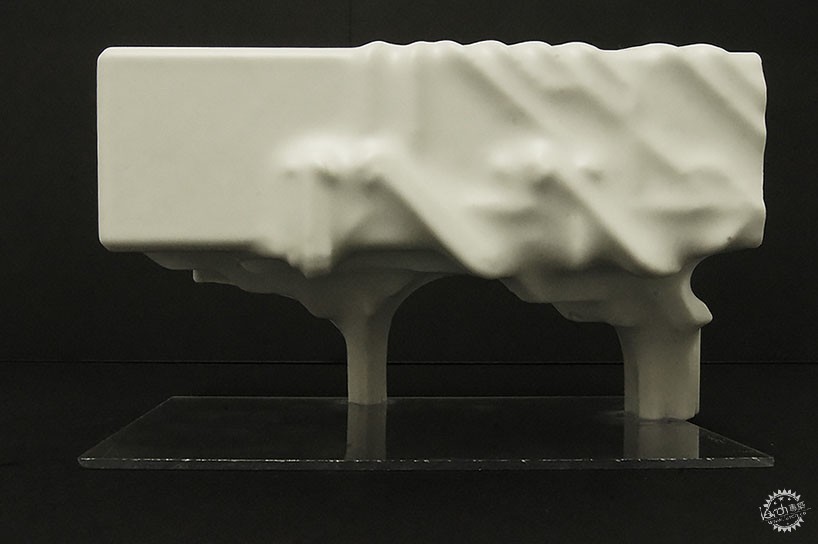
实体模型/Physical model
设计方案的出发点是要容纳分配大量服务管道。在制作虚拟和实体模型后,很显然管道和支撑系统可以融入一个更整体框架,呈现为悬垂网状物。这种管道、管路和管子组成的三维网络创建出一个更大更稳定的框架,来环绕或支撑底部的体块。一些管道位于顶部,形成了中庭上一系列的重叠结构。在底部,管道集中成一束,像树木一样向上开始分支。这些管道应该是基于C-Fab技术建立,任何复杂表面可以用3D打印出空间加固结构,并与传统填充物结合起来。最后在现场组装这些部件。
The demand in large numbers of service ducts became the starting point in exploring design solutions. After virtual and physical prototypes, it was clear that the channels and bearing systems can be blended into one larger frame to create an incredible overhanging web. This three-dimensional network of ducts, manifolds and pipes creates a spatially stable structure which encircles and bear blocks located at the base — bigger and heavier. Some of the ducts go to the top, forming strings of overlapping structures over the atrium. At the bottom, tubes are concentrated in bunches like tree trunks that begin to branch upwards. The pipes are supposed to be built with C-Fab technology, which 3D prints spatial reinforcement for surfaces of any complexity that can be combined with conventional fillers. Then, all final pieces would be assembled on site.
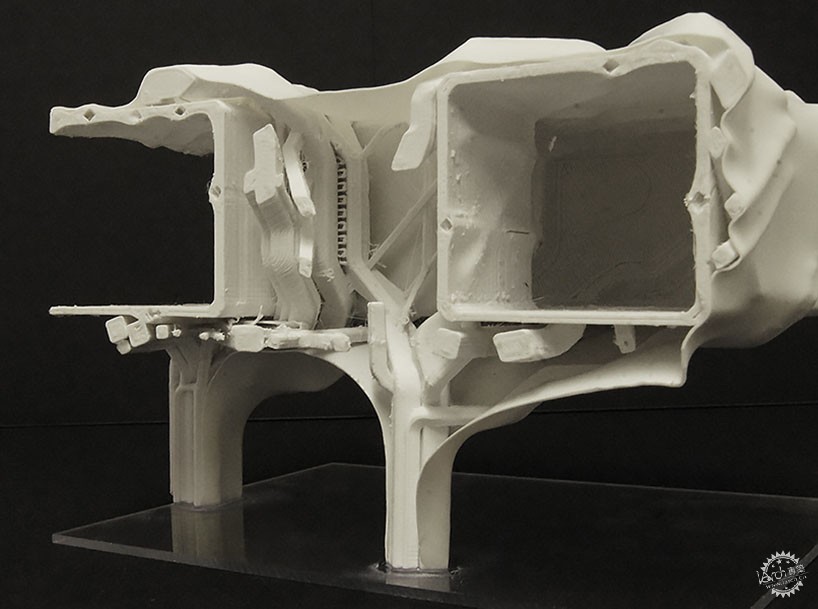
部分物理模型/Physical model of the fragment
为确保框架的稳定性,实验室需要更多的管道形成的框架,留有一些空置状态的承重管道框架。以后有需要的话,闲置的道可以投入运行,原本在用的管道停止运行。这样就有了灵活机动性和重新组织的可能,它像一个完整的生态系统,承接一步一步的进化。最后,科学中心的外观也表现出生命物的隐喻。外壳紧紧包裹的建筑物让人想起皮肤下的脉络或者沥青路下的树根。甚至在一些地方,它变得半透明,让散射的阳光穿透。
建筑综合体的室内有丰富的公共和半公共的空间。结构“枝干”的丰富性提供了不同等级的隐私空间——使员工能够寻找一个更舒适的环境与同事进行交流和互动。
To ensure stability of the framework, more ducts and pipes are needed for the lab supply — yet some remain empty with a bearing capacity. In the future, if required, empty vessels could be put in operation or contrariwise, the functional ones could be stopped. Thereby the proposal supposes flexibility and possibility for re-organization — like a complete living system assuming a step by step evolution. Finally, the exterior of the science center also discloses a metaphor on living organisms. The shell tightly enveloping the structure recalls the veins under the skin or tree roots under asphalt. Even more, in some places it becomes translucent, letting the scattered light penetrate.
The interior of the building complex is rich in public and semi-public spaces. The abundance of structural ‘trunks’ makes offers a gradation of zones with different level of privacy — enabling employees to look for a more comfortable surrounding to communicate and interact with their colleagues.
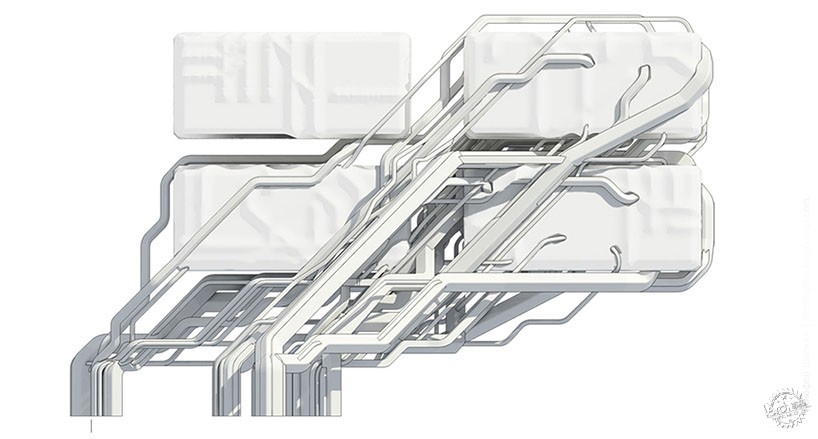
支撑结构/Bearing supply structure
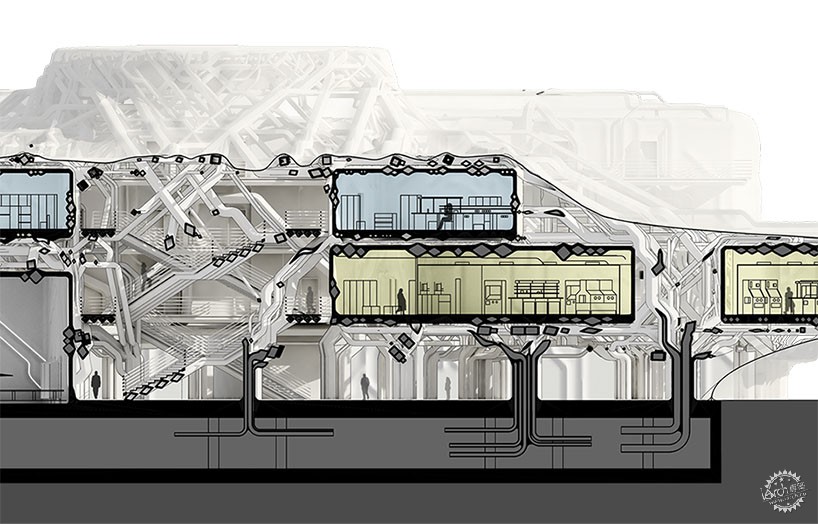
建筑局部剖面/Fragment of the building section
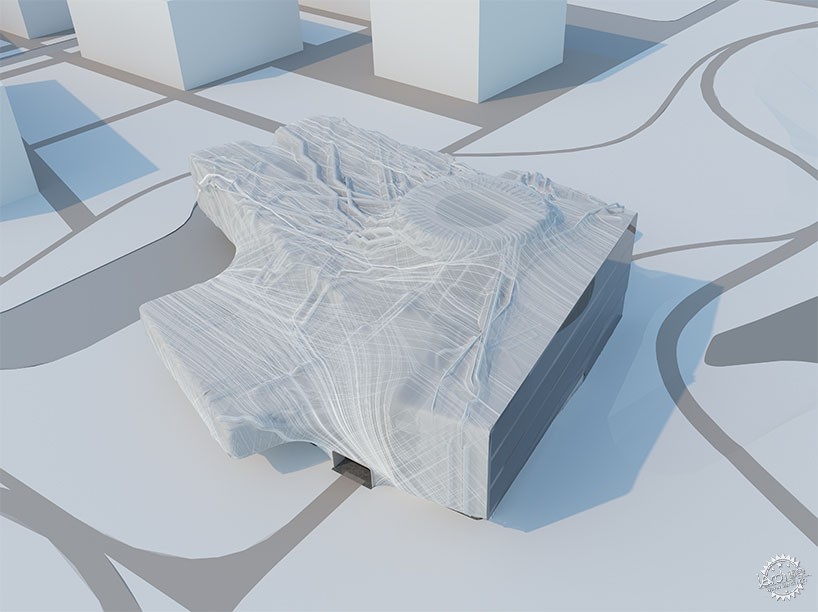
研究所鸟瞰/Bird’s eye view of the research facility
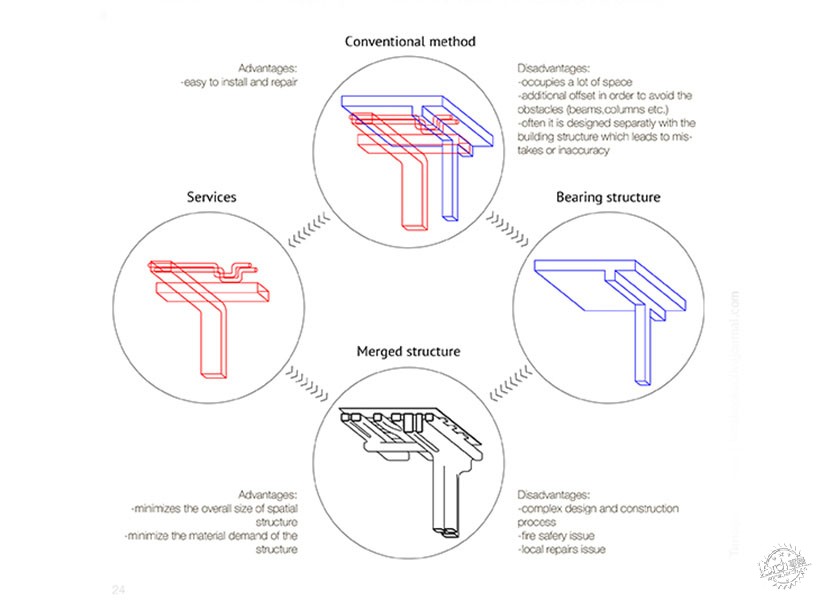
结构概念图示/Structural concept diagram
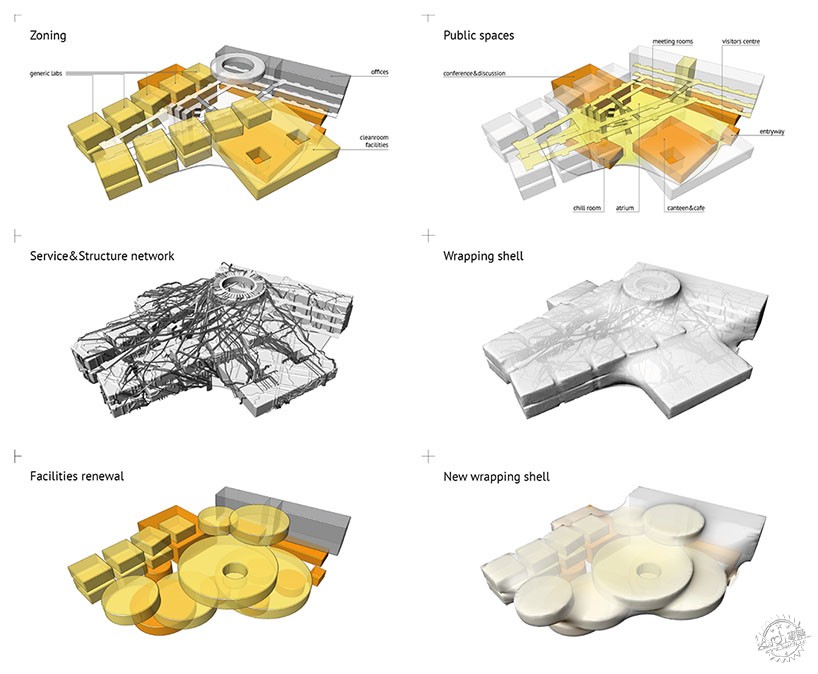
功能图示/Functional diagrams
出处:本文译自www.designboom.com/,转载请注明出处。
|
|
